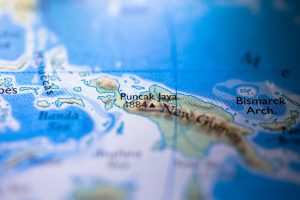On a limestone ridge near Indonesia’s tallest peak lies a little-known remnant of climate history. A cluster of ice caps nestled in the rocky terrain around Puncak Jaya are the last tropical glaciers of the Pacific.
Located within Lorentz National Park in Central Papua Province, the ice sheets are climate survivors on an island famous for its rainforests. However, their high-altitude perch above 15,000 feet ensures that the glaciers stay frozen year-round.
But not for long, warn climate scientists.
Indonesia’s meteorological agency recently reported a 66 percent decline in glacier thickness since December 2022. The ice cap that once blanketed the slopes had shrunk to a small patch under one square kilometer. “The probable cause is the 2022-2023 El Nino phenomenon,” said Donaldi Permana, a paleoclimatologist at Badan Meteorologi, Klimatologi dan Geofisika (BMKG).
In 2019, Permana co-authored a paper with a team of scientists from Ohio State University predicting that strong El Niños would play a role in bringing about “unstoppable glacier demise” at Puncak Jaya. Climatologist Lonnie Thompson, who pioneered new techniques in ice-core drilling, was a member of the expedition that conducted fieldwork at the glacier. He told Science Daily that proximity to a warming Pacific made Indonesia’s glaciers “canaries in the coal mine” of climate change.
The study concluded that ice thinning was “dramatic” during the El Niño of 2015-16. El Niño–Southern Oscillation occurs every two to seven years across the tropical Pacific, bringing warm temperatures and dry spells that together inhibit glacial ice formation. The scientists measured the ice thinning at “accumulation stakes” or PVC pipes embedded in the glacier.
Three ice cores extracted in 2010 provided a 50-year window on climate variation in the region. Preserved in an ice-core freezer at Byrd Polar and Climate Research Center at Ohio State University, the samples are the only glacier record for the Western Pacific Warm Pool, a “heat engine” with higher than average sea and air temperatures. An analysis of the oxygen isotopes in the ice core indicated that glacier retreat speeds up during the El Niño–Southern Oscillation.
Scientists who participated in the drilling expedition to Puncak Jaya blogged about the project’s logistical challenges. “With the drills essential to our work apparently lost somewhere in transit, Lonnie and I finally backtracked to Jakarta–a five-hour flight–and found them sitting in an airline warehouse!” wrote Dwi Susanto, an oceanographer at Columbia University’s Lamont-Doherty Earth Observatory.
Retrieving the ice cores was “a milestone for climate study in Indonesia,” declared Sri Woro B. Harijono, then head of BMKG.
Extrapolating from the climate data, the scientists predicted “total ice loss no later than 2026” for Indonesia’s glaciers. The ice caps of Puncak Jaya may defy the forecasts, but the long-term trend is clear. A 1989 paper published by the U.S. Geological Survey observed that the perennial ice fields in the region had “experienced rapid retreat during the 20th century.” A NASA report estimated that the glacier top of Puncak Trikora “disappeared completely some time between 1939 and 1962.”
Post-1970s, Landsat satellites began tracking the glaciers from space. “The ice area losses since the 1980s here are quite striking, visible in the contrast of the blue ice with the reddish bedrock,” commented Christopher Shuman, a geologist at NASA’s Goddard Space Flight Center. “Even though the area still gets snowfalls, it is clearly not sustaining these glacial remnants,” he added.
The Landsat photos highlighted another notable feature in the topography around Puncak Jaya: a vast open pit to the left of the peak. Operated by PT Freeport Indonesia, the Grasberg Mine holds one of the world’s largest reserves of gold and copper.
On a clear day, the glaciers are visible from the rim of the mine. Yohanes Kaize, a scientist at PT Freeport Indonesia, whose close-up shots of the glaciers appear in the 2019 study, told CNA: “As a Papuan myself, the only glacier in the Oceania region, the only one in Indonesia, I can say we are proud of this. But when it is gone, our pride will also diminish.”
































